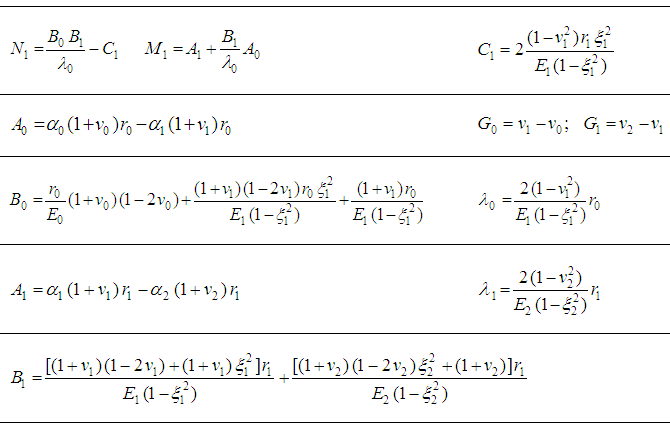-
Paper Information
- Previous Paper
- Paper Submission
-
Journal Information
- About This Journal
- Editorial Board
- Current Issue
- Archive
- Author Guidelines
- Contact Us
International Journal of Optics and Applications
p-ISSN: 2168-5053 e-ISSN: 2168-5061
2015; 5(5): 168-179
doi:10.5923/j.optics.20150505.05
On Impact of Dynamic Pressure and Thermal Loading on Refractive Index and Microbending Loss in Two-Layer Optical Fibers
Faramarz E. Seraji
Optical Communication Group, Iran Telecom Research Center, Tehran, Iran
Correspondence to: Faramarz E. Seraji, Optical Communication Group, Iran Telecom Research Center, Tehran, Iran.
| Email: |  |
Copyright © 2015 Scientific & Academic Publishing. All Rights Reserved.
This paper analyzes the impact of dynamic pressure on refractive index in two-layer optical fibers exerted on each layers, and then calculate the microbending losses developed in the fiber. In our analysis, we determine the tangential, radial, and axial stresses and refractive index changes of different layers. In the presence of axial strain and thermal reduction, if an external dynamic pressure is applied on a fiber, with the elapse of time, the resulting lateral pressure exerted on the fiber causes its structure to experience expansion and contraction under parametric changes of coating layers in response to dynamic changes. When the pressure has a tensile form, the microbending loss of the fiber attains negative value, which practically indicates no loss in fiber transmissions. At different time intervals, when the nature of lateral pressure changes, the effect of layers’ thickness, Young’s modulus, and Poisson’s ratio on microbending loss, normal stress components, and the refractive index would vary. At higher angular frequency of exerting dynamic pressure on fiber, the periodicity of the microbending loss changes would be lower.
Keywords: Dynamic pressure, Microbending loss, Two-Layer optical fibers
Cite this paper: Faramarz E. Seraji, On Impact of Dynamic Pressure and Thermal Loading on Refractive Index and Microbending Loss in Two-Layer Optical Fibers, International Journal of Optics and Applications, Vol. 5 No. 5, 2015, pp. 168-179. doi: 10.5923/j.optics.20150505.05.
Article Outline
1. Introduction
- Mechanical pressures and thermal loading are two main factors that can leave undesired effects on optical fibers, resulting in increase of transmission losses. To avoid such adverse conditions, communication fibers during production process, are usually coated with two to three layers of polymeric materials, in which the inner layer is of a soft material to prevent the microbending of the fiber structure and the outer one is of hard enough material to protect the fiber against severe environmental factors [1]. Both the layers have common roles of minimizing transmission losses of fibers, which mostly comprises of macro- and microbending losses [2-5]. Another major role of the fiber outer layer is to increase the mechanical strength of the produced fiber for which extensive work have earlier been reported (see e.g., [6-9]). In published works, the microbending loss and the radial, axial, and tangential stresses due to hydrostatic pressure and thermal loading have been dealt with to determine single [10] and two-layers [11-13] polymer coated optical fibers. Similar works have been reported for calculating microbending loss by considering a third tight layer jacketed over two-layer coated fibers [14, 15]. In another report [14] it is concluded that for minimizing the microbending loss due to lateral pressure, the Poisson’s ratio of primary and secondary coating, and the Young’s modulus of the jacket material should be increased and that of the primary coating should be decreased. A similar conclusion is drawn in case of two-layer coated optical fibers [11]. Yet, in another work, the combined optical effects of axial strain, thermal loading on double-coated optical fibers was analyzed [16].In our previous work, we have presented an analysis of the effect of temperature rise and hydrostatic pressure on microbending loss, refractive index change, and stress components of a double-coated optical fiber by considering coating material parameters such as Young’s modulus and the Poisson ratio [17].In this paper, we consider the dynamic nature of an exerting pressure along with a constant thermal loading applied on the fiber. For our model, we consider a two layer coated fiber, having first and second layers of soft and hard materials, respectively. In our analysis, we determine the pressure exerted on each layers and then calculate the microbending losses developed in fiber due to dynamic pressure and thermal variations. In our next attempt, we determine the tangential, radial, and axial stresses and refractive index changes of different layers.
2. Lateral Pressure and Layer Displacement at Boundary Interface
 | Figure 1. The fiber under dynamic pressure |
 with primary and secondary coatings of
with primary and secondary coatings of  and
and  , respectively, as shown in Fig. 1 [18-20]. Let the fiber be exposed to a dynamic pressure of
, respectively, as shown in Fig. 1 [18-20]. Let the fiber be exposed to a dynamic pressure of  and an axial strain of
and an axial strain of  along z-axis under a temperature reduction of ΔT. For simplicity, we further assume that the fiber and its coatings are axially symmetric in a cylindrical coordinate. The shear stress and strain are taken zero in three orthogonal directions. By ignoring theory of viscoelasticity and by considering the theory of elasticity, we can write the following expressions [20, 21]:
along z-axis under a temperature reduction of ΔT. For simplicity, we further assume that the fiber and its coatings are axially symmetric in a cylindrical coordinate. The shear stress and strain are taken zero in three orthogonal directions. By ignoring theory of viscoelasticity and by considering the theory of elasticity, we can write the following expressions [20, 21]: | (1) |
 | (2) |
 | (3) |
 ,
,  , and
, and  are radial, tangential, and axial stresses, respectively, and
are radial, tangential, and axial stresses, respectively, and  ,
,  , and
, and  represent the respective strains. Using (2) and (3), we can write:
represent the respective strains. Using (2) and (3), we can write: | (4) |
 is the fiber or given coating displacement at radius
is the fiber or given coating displacement at radius  . The ratio
. The ratio  indicates the tangential strain.Throughout our analysis, the values of Young’s modulus
indicates the tangential strain.Throughout our analysis, the values of Young’s modulus  , thermal expansion coefficient
, thermal expansion coefficient  , and Poisson ratio
, and Poisson ratio  are considered constant in each layer.By using Lamé formula,
are considered constant in each layer.By using Lamé formula,  and
and  in a cylindrical structure with inner and outer diameters of
in a cylindrical structure with inner and outer diameters of  and
and  , respectively, under external
, respectively, under external  and internal
and internal  pressures, are given as [22]:
pressures, are given as [22]: | (5) |
 | (6) |
 | (7) |
 is the ratio of
is the ratio of  to
to  of the coating layer.Let the displacement of fiber with respect to primary coating be denoted by
of the coating layer.Let the displacement of fiber with respect to primary coating be denoted by  and the displacement of primary coating with respect to the fiber be shown by
and the displacement of primary coating with respect to the fiber be shown by  . Therefore, by help of (7), we can write:
. Therefore, by help of (7), we can write: | (8) |
 | (9) |
 is the lateral dynamic pressure exerted on the primary coating layer and
is the lateral dynamic pressure exerted on the primary coating layer and  is the lateral pressure between the primary and the secondary coating layers, and
is the lateral pressure between the primary and the secondary coating layers, and  . The radial displacement of the primary coating layer at the interface with the secondary coating layer
. The radial displacement of the primary coating layer at the interface with the secondary coating layer  and the corresponding parameter for the secondary coating layer with respect to the primary coating layer
and the corresponding parameter for the secondary coating layer with respect to the primary coating layer  are given, respectively, as:
are given, respectively, as: | (10) |
 | (11) |
 and
and  at
at  , and
, and  and
and  at
at  , the lateral pressure exerted on the fiber can be obtained in terms of temperature variations, dynamic pressure, and axial strain as [18]:
, the lateral pressure exerted on the fiber can be obtained in terms of temperature variations, dynamic pressure, and axial strain as [18]: | (12) |
 | (13) |
|
3. Periodic Dynamic Pressure
- To examine the dynamic pressure, thermal loading, and the axial strain on the fiber attenuation, let us consider a pressure having a sinusoidal variation exerted on the fiber given as [18]:
 | (14) |
 and ω are the pressure amplitude and the angular frequency, respectively, and
and ω are the pressure amplitude and the angular frequency, respectively, and  represents the time factor.
represents the time factor.4. Microbending Losses
- Experimentally, it was shown that the microbending losses and the exerting pressure are related as [18, 23-26]:
 | (15) |
 is a constant equal to 0.0029 (dB/km)/MPa.
is a constant equal to 0.0029 (dB/km)/MPa. 5. Stress Components
- The lateral pressures exerted on the coating boundaries, create orthogonal stresses within the coating layers. The radial and tangential stresses are obtained by (5) and (6) and the axial stress is given as:
 | (16) |
 | (17) |
 | (18) |
 | (19) |
 | (20) |
 | (21) |
 | (22) |
 | (23) |
 | (24) |
6. Refractive Index Variations
- The lateral pressure exerted on the interface of the fiber and the first coating layer causes a change of fiber geometry and thus results in incremental orthogonal variations of refractive index of the cross section along the fiber. The refractive index variations dependence on the axial, tangential, and radial stresses are, respectively, given as follows [19-21]:
 | (25) |
 | (26) |
 | (27) |
 is the refractive index of fiber before any pressure and thermal loading are applied, and
is the refractive index of fiber before any pressure and thermal loading are applied, and  ,
,  , and
, and  are the corresponding indices changes along orthogonal directions.
are the corresponding indices changes along orthogonal directions.  and
and  are the stress-optical constants for ordinary and extraordinary rays, respectively.
are the stress-optical constants for ordinary and extraordinary rays, respectively.7. Numerical Calculations
- The effects of the sinusoidal variations of the exerting pressure on two-layer fiber was examined by using the specifications given in Table 2 with dynamic pressure amplitude of 2
 106 and axial strain of 1
106 and axial strain of 1 10-4. In Fig. 2, the microbending loss is plotted with respect to time for the angular frequency changes of 2, 20, 200, and 2000 rad/s.
10-4. In Fig. 2, the microbending loss is plotted with respect to time for the angular frequency changes of 2, 20, 200, and 2000 rad/s. 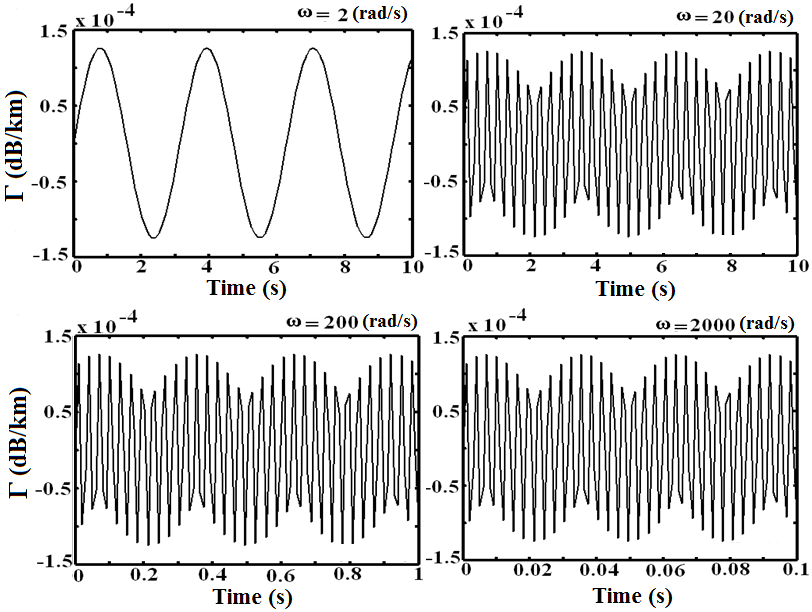 | Figure 2. Effects of dynamic pressure on the microbending loss vs. time at different angular frequencies |
|
 and
and  . The pressure amplitude is taken as 2
. The pressure amplitude is taken as 2 106 Pa and the radial strain as 1
106 Pa and the radial strain as 1 10-4.
10-4. | Figure 3. Effects of primary  and secondary and secondary  layers thickness on the microbending loss layers thickness on the microbending loss |
 s, when the dynamic pressure is non-existent, one order of magnitude decrease is observed in fiber loss. The losses decrease with increase of first layer thickness at calculated times except at
s, when the dynamic pressure is non-existent, one order of magnitude decrease is observed in fiber loss. The losses decrease with increase of first layer thickness at calculated times except at  s, at which the loss increases towards more positive value. At this time, the pressure amplitude is within its negative excursion, causing a tensile lateral pressure on fiber, as shown in Fig 2.In Fig. 3, the effect of second layer thickness on the loss is plotted under the same condition as that of Fig. 2. In the case of no-pressure condition, i.e., at
s, at which the loss increases towards more positive value. At this time, the pressure amplitude is within its negative excursion, causing a tensile lateral pressure on fiber, as shown in Fig 2.In Fig. 3, the effect of second layer thickness on the loss is plotted under the same condition as that of Fig. 2. In the case of no-pressure condition, i.e., at  s, an increase in second layer thickness causes loss increase, opposite to the case in Fig. 2. At other times, qualitatively, the nature of loss variation is the same as in Fig. 2. In both the cases in Figs 2 and 3, the first and second layers can not act effectively to reduce the compressive dynamic pressure being exerted on fiber.Based on expression (15), in Fig. 4, the fiber loss is plotted versus Young modulus variations of first layer at different times with the same values of dynamic pressure and axial strain. This set of curves show that an increase of Young’s modulus of soft layer up to
s, an increase in second layer thickness causes loss increase, opposite to the case in Fig. 2. At other times, qualitatively, the nature of loss variation is the same as in Fig. 2. In both the cases in Figs 2 and 3, the first and second layers can not act effectively to reduce the compressive dynamic pressure being exerted on fiber.Based on expression (15), in Fig. 4, the fiber loss is plotted versus Young modulus variations of first layer at different times with the same values of dynamic pressure and axial strain. This set of curves show that an increase of Young’s modulus of soft layer up to  s, the fiber loss increases. Even when no dynamic pressure is exerted on fiber, the loss increase is observed. At
s, the fiber loss increases. Even when no dynamic pressure is exerted on fiber, the loss increase is observed. At  s, the loss attains negative values and decreases with increase of Young’s modulus of the first layer.
s, the loss attains negative values and decreases with increase of Young’s modulus of the first layer. | Figure 4. The effects of Young’s modulus of layers on microbending loss |
 s, when the dynamic pressure is not applied, a loss increase develops in fiber which is due to axial strain and temperature drops. The positive loss at this time is the result of a net compressive pressure on the fiber. At
s, when the dynamic pressure is not applied, a loss increase develops in fiber which is due to axial strain and temperature drops. The positive loss at this time is the result of a net compressive pressure on the fiber. At  s, the tensile pressure on the fiber increases, resulting in negative loss increase.With relation to expression (15), in Fig. 5, the effects of Poisson ratios of the first and second layers on fiber loss are, respectively, shown with dynamic pressure amplitude of 2
s, the tensile pressure on the fiber increases, resulting in negative loss increase.With relation to expression (15), in Fig. 5, the effects of Poisson ratios of the first and second layers on fiber loss are, respectively, shown with dynamic pressure amplitude of 2 106 at angular frequency of 2 rad/s and strain: of 1
106 at angular frequency of 2 rad/s and strain: of 1 10-4. At
10-4. At  and 2 s, an increase of Poisson ratio of the first layer causes reduction in the fiber loss whereas that of the second layer makes the fiber loss to decrease. At other calculation times, the loss variations reverse as compared with first two time intervals.
and 2 s, an increase of Poisson ratio of the first layer causes reduction in the fiber loss whereas that of the second layer makes the fiber loss to decrease. At other calculation times, the loss variations reverse as compared with first two time intervals.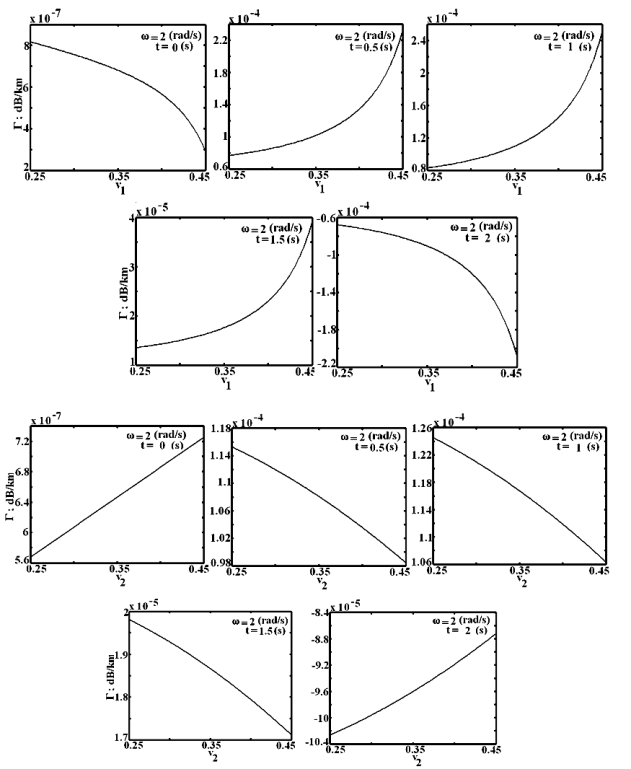 | Figure 5. The effects of Poisson ratio of layers on microbending loss |
 s, the normal stress components are negative within the two layers. Within these time intervals, the radial stress increases and tangential stress decreases with increase of layer thickness. On the contrary, at
s, the normal stress components are negative within the two layers. Within these time intervals, the radial stress increases and tangential stress decreases with increase of layer thickness. On the contrary, at  s, the variations of the radial and tangential stresses reverse. The axial stress within the layers remains constant in all the calculation time intervals.
s, the variations of the radial and tangential stresses reverse. The axial stress within the layers remains constant in all the calculation time intervals.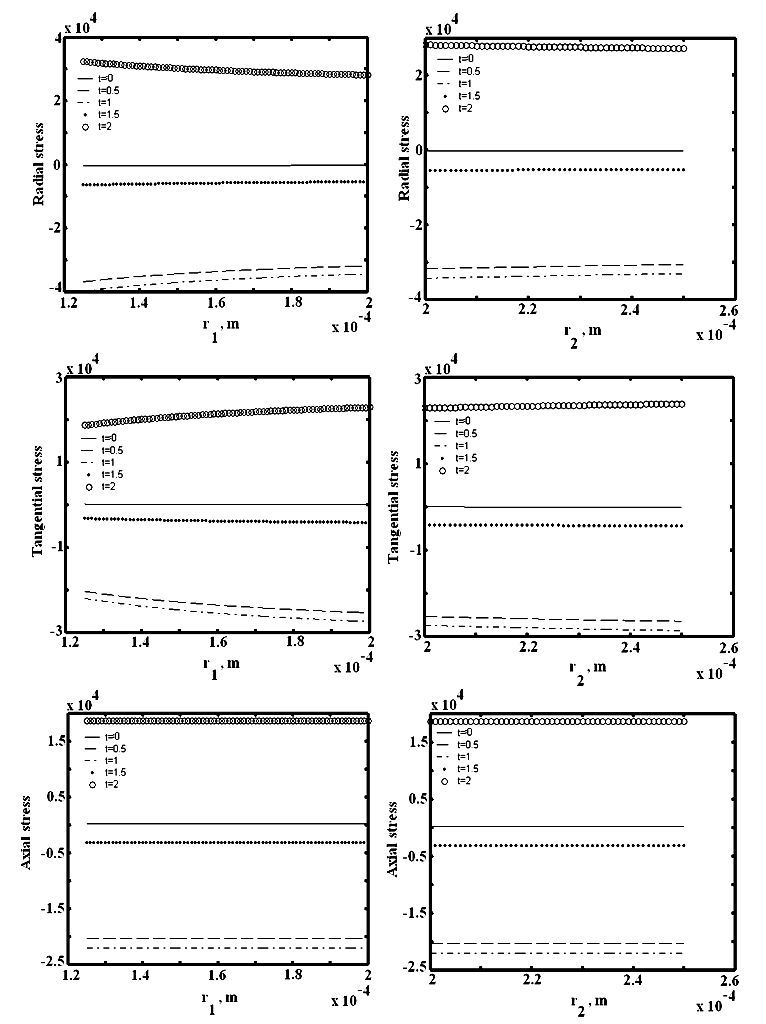 | Figure 6. The effects of layers thicknesses on normal stresses at different times |
 s, the refractive index changes attain decreasing positive values in both the layers, whereas at
s, the refractive index changes attain decreasing positive values in both the layers, whereas at  s, the values become increasingly negative along three directions. In the both cases, the fiber gets compressed and expanded, respectively, under influence of external factors.
s, the values become increasingly negative along three directions. In the both cases, the fiber gets compressed and expanded, respectively, under influence of external factors.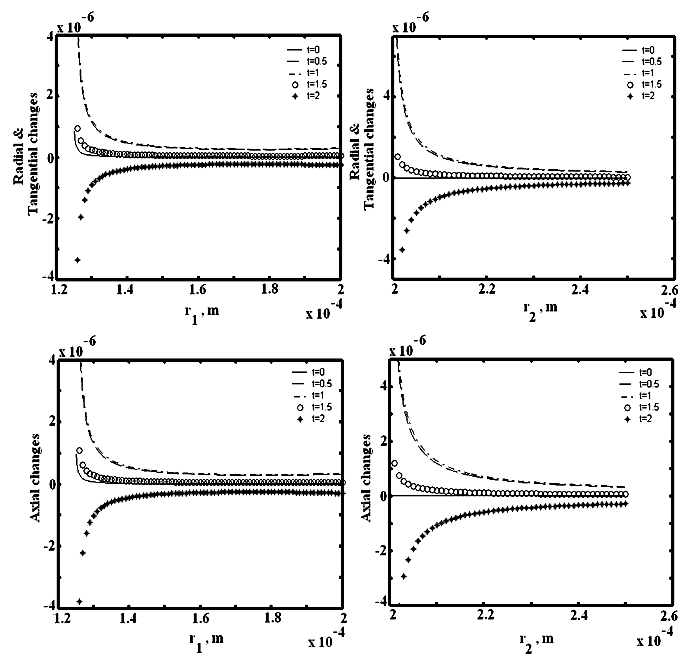 | Figure 7. The effects of layers thicknesses on refractive index changes at different times |
 s, the refractive indices changes reduce with negative values with respect to the parametric changes in the first layer, resulting in a stretch of the fiber. In the second layer, the condition reverses.
s, the refractive indices changes reduce with negative values with respect to the parametric changes in the first layer, resulting in a stretch of the fiber. In the second layer, the condition reverses.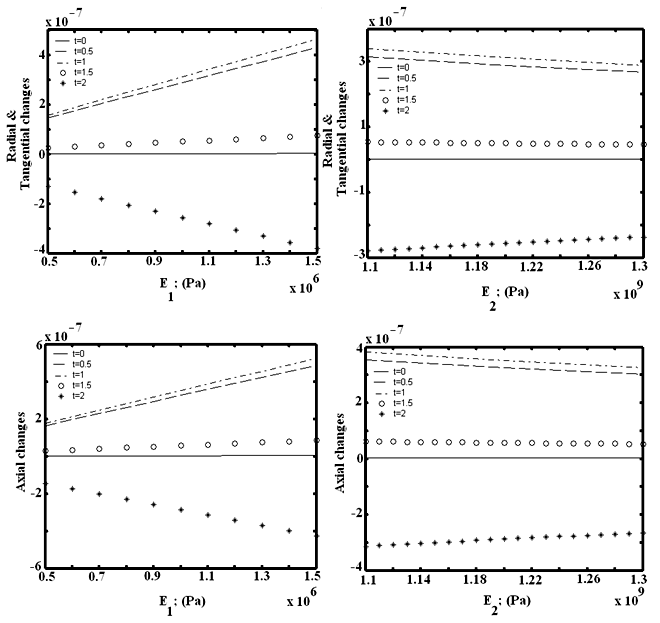 | Figure 8. The effects of Young’s modulus of layers on refractive indices changes at different times |
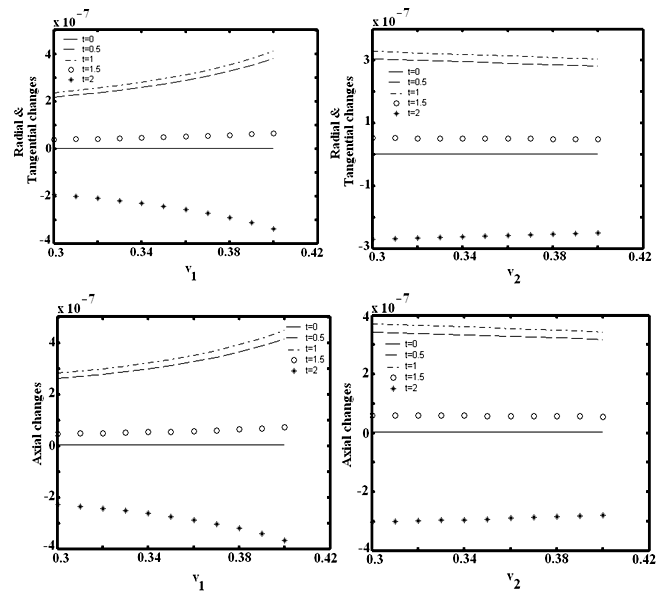 | Figure 9. The effects of Poisson ratio of layers on refractive indices changes at different times |
8. Conclusions
- We have analyzed the effects of dynamic pressure, temperature reduction, and axial strain on index variations of two-layer optical fibers and microbending loss.In the presence of axial strain and thermal reduction, if an external dynamic pressure is applied on a fiber, with the elapse of time, the resulting lateral pressure exerted on the fiber causes its structure to experience expansion and contraction under parametric changes of coating layers in response to dynamic changes. When the pressure has a tensile form, the microbending loss of the fiber attains negative value, which practically indicates no loss in fiber transmissions. The effects of parameters such as Young’s modulus, Poisson’s ratio, and thickness of the layers on microbending loss, normal stress components, and the refractive index are functions of time. At different time intervals, when the nature of lateral pressure changes, the effect of thickness, Young’s modulus, and Poisson’s ratio on microbending loss, normal stress components, and the refractive index would vary, accordingly, unlike in case of hydrostatic pressure, where the effects of the parameters remain constant. The more the angular frequency of exerting dynamic pressure on fiber, lesser the changing periodicity of the microbending loss.The results obtained in this analysis may be utilized in under-sea optical fiber transmission links, where dynamic pressures due to presence of water waves may exist.
 Abstract
Abstract Reference
Reference Full-Text PDF
Full-Text PDF Full-text HTML
Full-text HTML